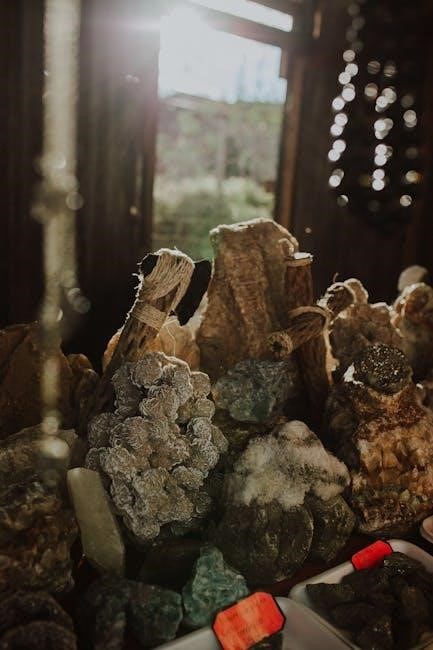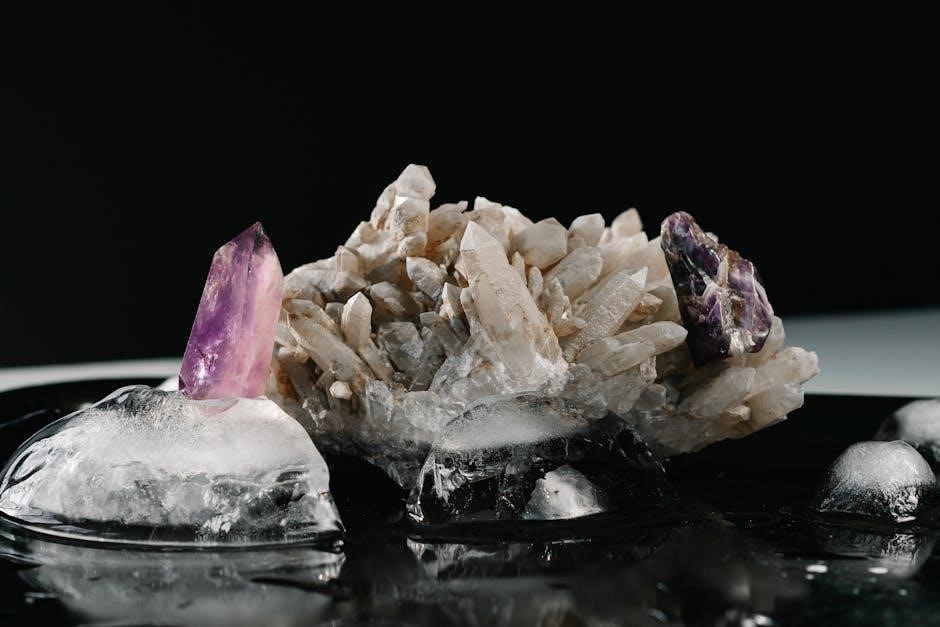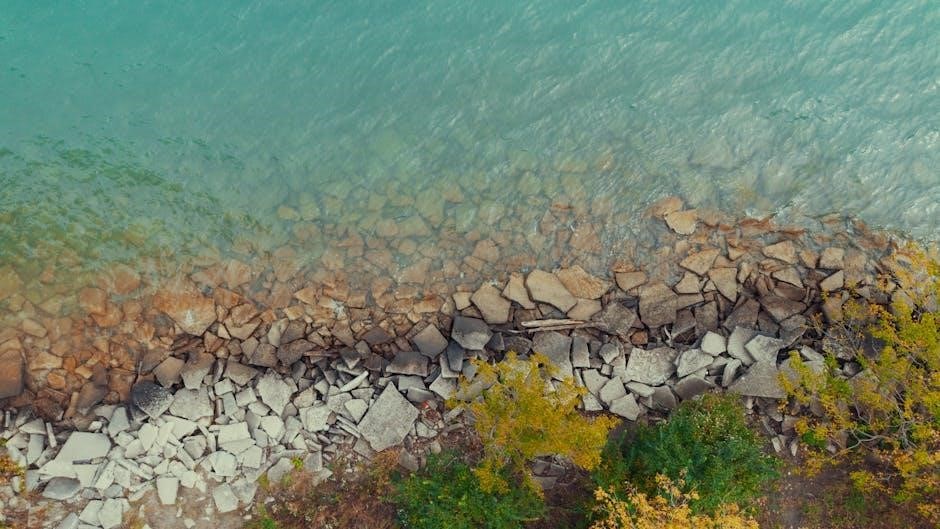Geology explores Earth’s materials, processes, and history. Rocks and minerals are fundamental, with minerals being naturally occurring inorganic substances and rocks as their aggregates. Understanding these elements aids in studying Earth’s structure and geological processes.
1.1 Definition of Geology
Geology is the scientific study of the Earth’s physical structure, composition, and processes. It encompasses the study of minerals, rocks, and the processes that shape the planet. Geology provides insights into the Earth’s history, including the formation of landscapes, the creation of natural resources, and the forces that have shaped the planet over millions of years.
1.2 Overview of Rocks and Minerals
Rocks and minerals are the building blocks of the Earth’s crust. Minerals are naturally occurring inorganic substances with specific chemical compositions and structures. Rocks are aggregates of minerals, forming solid masses. They can be classified into types like igneous, sedimentary, and metamorphic, each with unique compositions and formation processes, reflecting the dynamic geological history of the planet.
Classification of Rocks
Rocks are classified based on their origin into igneous, sedimentary, and metamorphic types. This classification aids in understanding their formation processes, composition, and geological significance.
2.1 Igneous Rocks
Igneous rocks form from cooled magma or lava, either beneath Earth’s surface (intrusive) or above it (extrusive). They vary in texture, from coarse-grained granites to fine-grained basalts, depending on cooling rates. Common minerals include quartz, feldspar, and mica. Their formation is crucial in understanding Earth’s thermal and magmatic processes, shaping the planet’s crust over millions of years.
2.2 Sedimentary Rocks
Sedimentary rocks form through the accumulation and consolidation of sediments, such as mineral particles or organic matter. These rocks can be classified into three main types: clastic (e.g., sandstone), chemical (e.g., limestone), and organic (e.g., coal). They provide valuable information about Earth’s historical environments and are often rich in fossils, offering insights into the planet’s past life forms and climatic conditions.
2.3 Metamorphic Rocks
Metamorphic rocks are formed when existing rocks undergo transformations due to high temperature, pressure, or chemical processes without melting. Examples include marble from limestone and slate from shale. These rocks reveal tectonic forces and crustal dynamics, offering insights into Earth’s internal processes and geological history through their altered mineral compositions and textures. Their study is crucial for understanding crustal evolution and plate tectonics.

Minerals: Building Blocks of Rocks
Minerals are naturally occurring inorganic substances with specific chemical compositions and structures. They form the foundation of rocks, which are aggregates of one or more minerals.
3.1 Definition and Characteristics of Minerals
Minerals are naturally occurring inorganic substances with specific chemical compositions and ordered atomic structures. They form through geological processes like cooling magma or metamorphism. Minerals are characterized by their unique physical properties, such as hardness, color, and crystal form. Examples include quartz and feldspar, which are essential in rock formation and exhibit distinct mineralogical traits.
3.2 Common Rock-Forming Minerals
Common rock-forming minerals include quartz, feldspar, mica, amphiboles, and olivine. These minerals are widespread in igneous, sedimentary, and metamorphic rocks. Quartz, for example, is highly abundant due to its stability, while feldspar dominates igneous rocks. Mica minerals add flexibility and shine to rocks like schist. Their combinations define the type and properties of rocks, making them geologically significant.
3.3 Economic Importance of Minerals
Minerals are crucial for the global economy, providing raw materials for industries. Metals like iron, copper, and aluminum are essential for construction and manufacturing. Precious stones such as diamonds and gold are valuable for jewelry and investment. Additionally, minerals like quartz and feldspar are used in electronics and ceramics. Their extraction and trade drive significant economic activities worldwide, making them indispensable resources.
Formation Processes of Rocks and Minerals
Rocks and minerals form through geological processes like cooling magma, crystallization, and sedimentation. These processes shape Earth’s materials, creating diverse rock types and mineral deposits over time.
4.1 Magmatic and Metamorphic Processes
Magmatic processes involve the cooling and solidification of magma, forming igneous rocks like granite and basalt. Metamorphic processes alter existing rocks under high pressure and temperature, creating marble from limestone or slate from shale. These transformations are crucial in shaping Earth’s crust.
4.2 Sedimentary Processes
Sedimentary processes involve the formation of rocks through erosion, deposition, and lithification. Sediments like sand, silt, and shells are compressed and cemented together, forming rocks such as sandstone and limestone. These processes occur in environments like rivers, oceans, and deserts, shaping Earth’s surface and preserving fossils, providing insights into geological history and past life forms.
The Role of Petrology in Studying Rocks
Petrology is the study of rocks, focusing on their origin, composition, and properties. It examines mineral composition, textures, and formation processes, aiding in rock classification and understanding geological events.
5.1 What is Petrology?
Petrology is the scientific study of rocks, examining their origin, composition, and properties. It involves analyzing textures, mineral compositions, and geological contexts to classify rocks and understand their formation processes. Petrology integrates mineralogy, geology, and geochemistry to provide insights into Earth’s history and crustal evolution, aiding in the identification of diverse rock types and their significance.
5.2 Classification of Rocks Based on Mineral Composition
Rock classification based on mineral composition involves categorizing them into igneous, sedimentary, and metamorphic types. Igneous rocks are primarily composed of silicate minerals like quartz and feldspar. Sedimentary rocks often contain calcite or clay minerals, while metamorphic rocks may include mica or amphibole. This classification helps in understanding the geological processes and environments that formed the rocks.
Silicate Minerals: The Most Abundant Group
Silicate minerals dominate Earth’s crust, comprising over 90% of all minerals. They include quartz, feldspar, and mica, formed by silicon-oxygen tetrahedra. Their diversity and abundance make them crucial in forming igneous, sedimentary, and metamorphic rocks, shaping the planet’s geology.
6.1 Types of Silicate Minerals
Silicate minerals are diverse, with key types including quartz, feldspar, mica, amphibole, and olivine. Quartz is the most common, while feldspar is abundant in igneous rocks. Mica forms in metamorphic rocks, amphibole in igneous and metamorphic, and olivine in mantle rocks. These minerals vary in structure and composition, but all contain silicon-oxygen tetrahedra, making them foundational to Earth’s crust.
6.2 Importance of Silicate Minerals in Rock Formation
Silicate minerals are crucial in rock formation, comprising over 90% of Earth’s crust. They form igneous, sedimentary, and metamorphic rocks. Quartz and feldspar dominate igneous rocks like granite, while mica and amphibole are key in metamorphic rocks. Their diverse structures and compositions allow them to adapt to various geological conditions, making them essential building blocks of Earth’s lithosphere and influencing its geological processes significantly.

Mineral Resources and Their Geological Significance
Mineral resources are concentrations of minerals with economic value, formed through geological processes. They are vital for industrial and technological advancements, shaping human progress and global economies significantly.
7.1 Distribution and Formation of Mineral Resources
Mineral resources are unevenly distributed, often concentrated in specific geological settings. Their formation involves magmatic, metamorphic, and sedimentary processes. Economic deposits develop through crystallization, weathering, or biological activity, influenced by temperature, pressure, and chemical conditions. These resources are crucial for industrial applications and human needs, making their study essential for sustainable extraction and resource management practices globally.
7.2 Commercial Value of Rock-Forming Minerals
Rock-forming minerals like quartz and feldspar have significant commercial value, driving industries such as ceramics, glass, and electronics. Their abundance and versatility make them essential raw materials. Economic demand for these minerals is high, supporting technological advancements and construction projects. Understanding their value aids in sustainable resource management and industrial applications, ensuring long-term availability for societal needs.

Quartz and Feldspar: Key Minerals in Rocks
Quartz and feldspar are crucial minerals in rock formation, dominating Earth’s crust. They exhibit remarkable durability and versatility, essential in various geological processes and industrial applications.
8.1 Quartz: Properties and Occurrence
Quartz, a hard, crystalline mineral composed of silicon and oxygen (SiO₂), is one of the most common minerals on Earth. It exhibits high durability and resistance to chemical weathering. Quartz occurs in igneous, sedimentary, and metamorphic rocks, often as a primary or secondary mineral; Its versatility makes it a key component in many geological formations and industrial applications.
8.2 Feldspar: Abundance and Uses
Feldspar is one of the most abundant mineral groups in the Earth’s crust, particularly in igneous rocks like granite. Comprising aluminum silicates, it is widely used in ceramics, glassmaking, and as an industrial raw material. Feldspar’s abundance and versatility make it a critical component in various geological and commercial applications, highlighting its significance in both natural and industrial contexts.

Minerals and Rocks: Their Interconnectedness
Minerals and rocks are intricately connected, as minerals form the building blocks of rocks. Rocks are aggregates of one or more minerals, shaping their composition and structure. This relationship is central to understanding geological processes and the Earth’s crust formation, highlighting their mutual importance in the planet’s makeup.
9.1 How Minerals Form Rocks
Minerals combine to form rocks through geological processes like crystallization, sedimentation, and metamorphism. Igneous rocks emerge as magma cools, while sedimentary rocks develop from compressed mineral particles. Metamorphic rocks form when existing minerals recrystallize under extreme conditions, creating new textures and structures. This process highlights the dynamic interplay between minerals and their role in shaping Earth’s crust.
9.2 Polymineralic vs. Monomineralic Rocks
Polymineralic rocks, like granite, contain multiple minerals, offering insights into complex geological processes. Monomineralic rocks, such as limestone, are composed of a single mineral, often reflecting specific formation conditions. This distinction aids in understanding Earth’s history and the diversity of rock formation mechanisms, emphasizing the role of mineral composition in geological studies and classifications.
Geological Processes and the Earth’s Crust
Geological processes shape the Earth’s crust through the formation and transformation of rocks and minerals. These processes include cooling of magma, mineral crystallization, and plate tectonics, forming diverse landscapes.
10.1 The Earth’s Crust Composition
The Earth’s crust is primarily composed of rocks and minerals, with silicate minerals like quartz and feldspar being the most abundant. It is formed through geological processes such as the cooling of magma and sedimentary deposits. The crust’s composition varies, including igneous, sedimentary, and metamorphic rocks, each shaped by distinct processes and conditions.
10.2 Geological Processes Shaping the Earth’s Surface
Geological processes such as weathering, erosion, and plate tectonics continually reshape the Earth’s surface. Igneous, sedimentary, and metamorphic rocks form through cooling magma, sediment compression, and high-pressure transformations. These processes create diverse landscapes, from mountain ranges to oceanic basins, illustrating the dynamic nature of Earth’s geology and its constant evolution over time.
Studying geology reveals Earth’s history, natural resources, and environmental challenges, equipping us to address future geological and societal needs effectively through informed decision-making and sustainable practices.
11.1 Understanding the Earth’s Structure
Geology provides insights into Earth’s composition, revealing layers like the crust, mantle, outer core, and inner core. The crust, composed of rocks and minerals, is studied to understand processes shaping our planet. Rock-forming minerals such as quartz, feldspar, and mica dominate the crust, while olivine and pyroxene prevail in the mantle. These elements form the foundation for understanding Earth’s dynamic systems and processes.
11.2 Geological Knowledge for Future Challenges
Geological knowledge is crucial for addressing future challenges like resource management, natural hazards, and climate change. Understanding rock formation and mineral distribution aids in sustainable resource extraction and mitigating environmental impacts. By studying geological processes, scientists can predict and prepare for earthquakes, volcanic eruptions, and land degradation, ensuring a more resilient and sustainable future for generations to come.
